The facts about women and tobacco
Although data show overall cigarette use has declined in the United States, they also highlight disparities in smoking rates. For example, overall smoking rates have not declined as quickly for women as for men. Since 1965, smoking rates among women have dropped by about 59 percent, compared with a 66 percent drop among men. Women who smoke also risk additional consequences, including reproductive issues such as menstruation problems, decreased fertility and premature menopause.
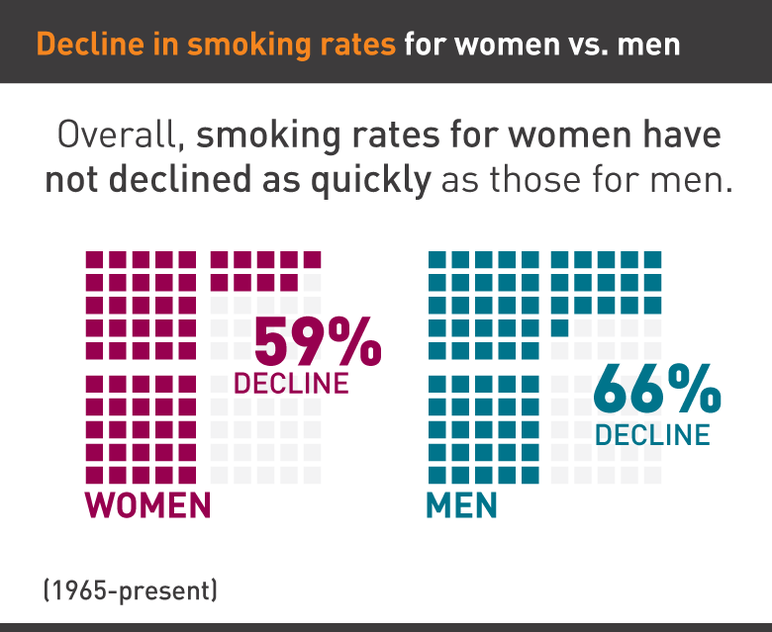
Patterns of Use in the U.S.
YOUTH
- Among high school students, 7.3 percent of females and 8.8 percent of males currently smoke cigarettes.
- Female high school students use non-cigarette tobacco products at a consistently lower rate than male high school students. For example:
- An estimated 18.8 percent of female high school students used e-cigarettes in 2018, compared with 22.6 percent of male high school students.
- While 6 percent of female high school students currently smoke cigars, 9 percent of male high school students are current cigar smokers.
- The amount of female high school students who use smokeless tobacco (3.3 percent) is less than half that of male high school students (8.4 percent).
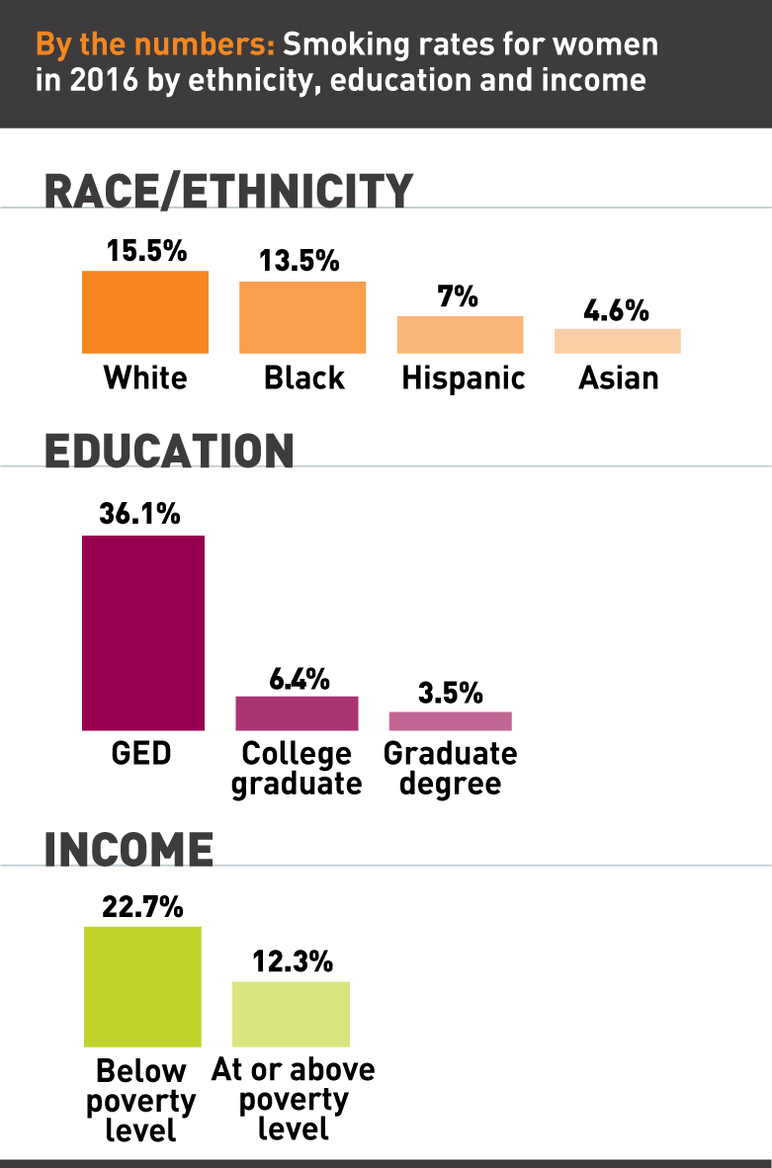
ADULTS
- In the U.S., 1 in 8 women is a smoker. In 2017, 12.2 percent of women smoked compared with 15.9 percent of men.
- In the U.S., smoking rates have historically been lower among women than men. However, as overall smoking rates have decreased over the years, they have not dropped as quickly for women as for men. Since 2005, smoking rates among women have declined by 25.4 percent, compared with a 26.8 percent decline among men. Additionally, smoking rates among women have dropped by about 59 percent since 1965, compared with a 66 percent drop among men.
- Smoking rates among women in the U.S. differ by race and ethnicity, education level and income.
- In 2016, 15.5 percent of white women, 13.5 percent of black women, 7 percent of Hispanic women and 4.6 percent of Asian women were current smokers.
- In 2017, smoking rates declined to 14.7 percent among white women, 11.3 percent among black women and 6.7 percent among Hispanic women.
- Smoking rates are highest among women who earned a GED diploma, at 36.1 percent. Among female college graduates, 6.4 percent are smokers, while only 3.5 percent of women with a graduate degree smoke.
- Approximately 22.7 percent of women below the poverty level smoke compared with 12.3 percent of women at or above the poverty level.
- For e-cigarettes, 2.4 percent of women have reported “every day” or “some day” use.

Industry Targeting
The tobacco industry has a long history of targeting women and continues to target women with cigarette advertising themes related to sex appeal, independence and stylishness, among others.
- Cigarette marketing toward women started in the early 1920s. Some of the first ads posed cigarettes as a means of weight loss.
- Companies started utilizing beauty and fashion trends to portray smoking as more feminine.
- One tobacco company organized a group of women to march in New York City’s 1929 Easter parade while holding cigarettes. The cigarettes were called “torches of freedom” in an effort to transform public perception of smoking as a social taboo for women.
- By the 1960s, tobacco companies began capitalizing on a growing women’s movement by marketing cigarettes with slogans like “It’s a woman thing” and “You’ve come a long way, baby.”
- Some brands introduced cigarettes marketed exclusively for women — like Virginia Slims, Eve, Misty and Capri. In 2007, R.J. Reynolds introduced a cigarette brand called Camel No. 9, a name evocative of designer perfume and women’s fashion. A study by the University of California at San Diego and Truth Initiative® found that the brand may have been effective in encouraging young girls to start smoking, with teen girls citing it as a favorite cigarette campaign.
- Philip Morris offered promotions in exchange for purchasing Virginia Slims cigarettes, including “V wear” catalogues with blouses, coats, scarves and accessories.
Health Effects
MORTALITY
- Every year, smoking-related diseases kill more than 200,000 women, making it the largest preventable cause of death among women in the U.S.
- The annual risk for death in women who smoke cigarettes is nearly 3 times (2.76) greater than in women who have never smoked cigarettes.
- From 1965 to 2014, about 6.4 million women died from smoking-attributable disease.
- Smoking accounted for an estimated 2.1 million years of potential life lost for U.S. women each year during the 2000s.
LUNG CANCER
- Lung cancer is the leading cause of cancer death among women.
- Women who smoke have 25.66 times the risk of lung cancer death compared with women who have never smoked.
- Lung cancer deaths have outnumbered breast cancer deaths in women since 1987.
- Women who smoke have 12.69 times the risk of dying from lung, trachea and bronchus cancers compared with women who never smoked.
CARDIOVASCULAR DISEASE
- About 62,000 women die each year of smoking-related cardiovascular diseases.
- Most cases of heart disease among women younger than 50 years old are a result of smoking. In fact, 88 percent of heart disease cases among women under age 50 who currently smoke are attributable to smoking.
- The annual death rate for cardiovascular disease has remained higher for women than men since 1984.
- Women who smoke have a 25 percent greater risk of developing coronary heart disease compared with men who smoke.
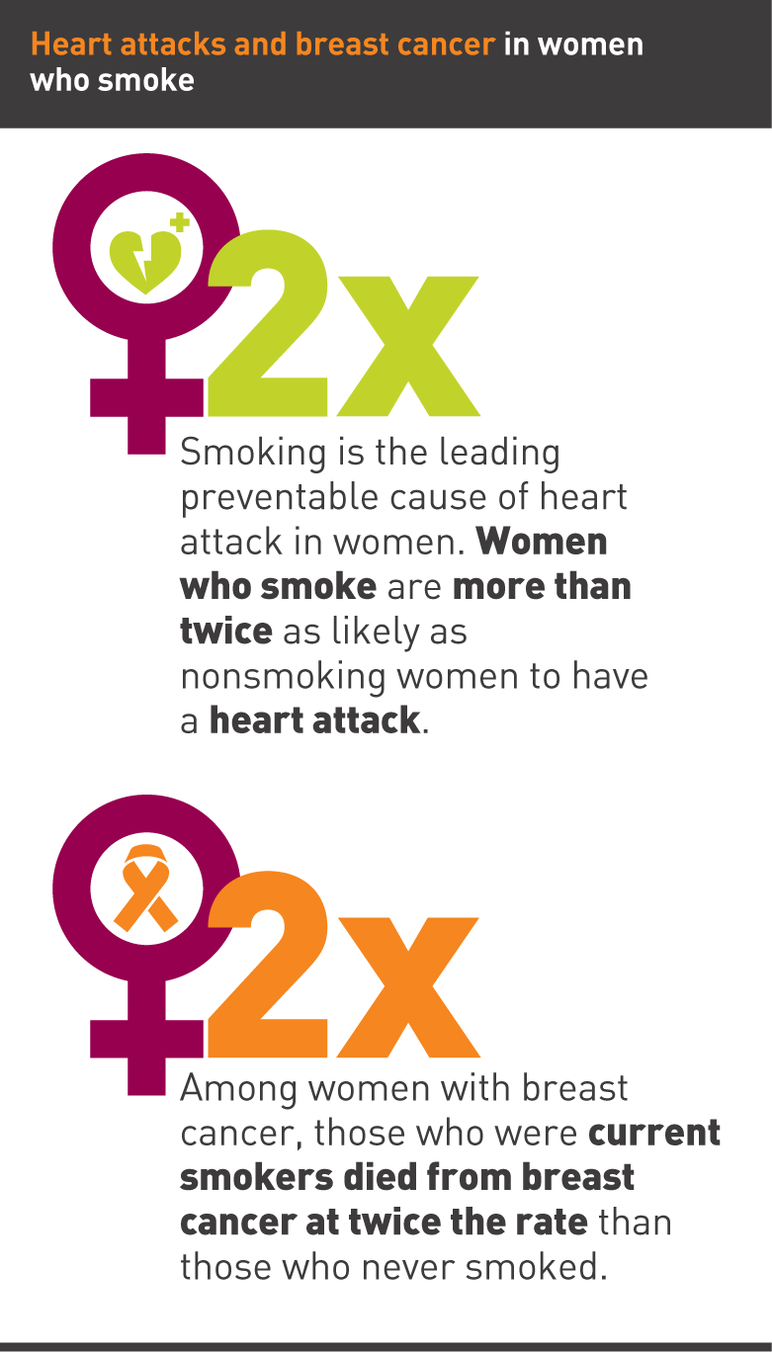
HEART ATTACK
- Smoking increases the risk of heart attack, and this relationship is more significant in women than men.
- One study found that women who smoke are more than twice as likely as nonsmoking women to have a heart attack. For both men and women, the risk of having a heart attack increases with the number of cigarettes smoked.
- Smoking is the leading preventable cause of heart attack in women.
BREAST CANCER
- Breast cancer is the second leading cause of cancer death in women after lung cancer. Cigarette smoking, as well as secondhand smoke exposure, have been associated with an increased risk of developing breast cancer.
- A study found that among women with breast cancer, those who were current smokers died from breast cancer at twice the rate than those who never smoked.
- There is an association between cigarette smoke exposure and increased invasiveness and malignancy in human breast cancer cells.
CERVICAL CANCER
- The association between smoking and increased risk for cervical cancer has been well documented. Although it is still unclear whether tobacco can independently cause cervical cancer, research has shown that smoking is a significant co-factor in the development of human papilloma virus (HPV)- driven cervical cancer.
- Most cervical lesions from HPV infections are known to heal on their own without progressing to cancer. However, studies have shown that smoking may delay regression of these lesions and increase the risk of persistent HPV infections on the cervix.
- Additional research has shown that among women with HPV infections, those who smoke had a significantly higher viral load on the cervix compared with nonsmoking women. Both persistence and viral load of HPV infections are associated with increased risk of developing cervical cancer.
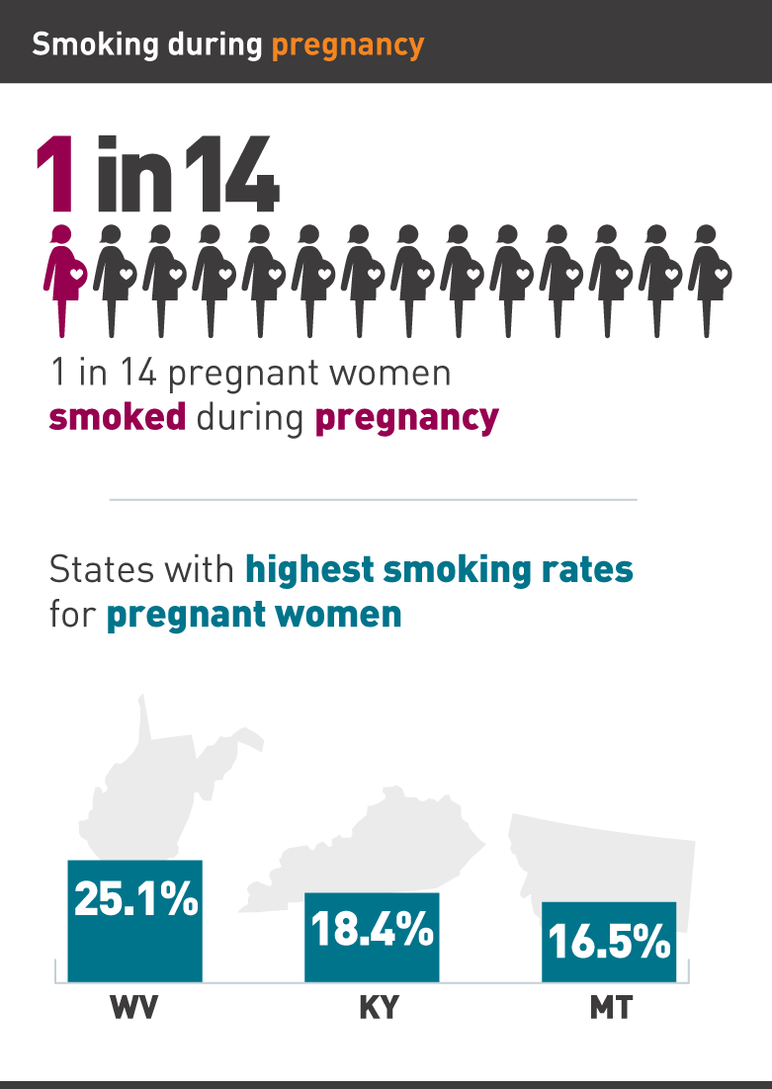
PREGNANCY
- In 2016, 1 in 14 (7.2 percent) women who gave birth reported that they had smoked during pregnancy.
- In 2016, women aged 20 to 24 were most likely to have smoked during pregnancy, at 10.7 percent, compared with other age groups.
- States with the highest smoking rates among women who are pregnant include West Virginia (25.1 percent), Kentucky (18.4 percent) and Montana (16.5 percent).
- Women who smoke increase their risk of infertility, ectopic pregnancy, spontaneous abortion and still birth.
- Smoking during pregnancy can have significant and long-lasting harmful effects on a developing fetus. Babies exposed to nicotine in utero tend to have low birth weight and decreased brain volume. They are also at an increased risk of sudden infant death syndrome, ADHD, asthma and more.
MENSTRUATION
- Smoking may increase the likelihood of developing moderate or severe premenstrual syndrome (PMS). This is especially true for women who started smoking during adolescence or early adulthood.
- In one study, women diagnosed with PMS who reported smoking as a teenager had a significantly higher risk of experiencing menstrual symptoms like acne, backache and anger.
- Smoking can increase the risk of irregular periods and premature menopause, and significantly change the length of a woman’s period.
COSMETIC CONCERNS
- Smoking tobacco causes premature aging and wrinkling of the skin.
- Adult women who currently smoke have about three times the risk of developing moderate to severe facial wrinkles compared with women who never smoked. The same risk for wrinkles among smoking men is twice that of men who never smoked.
- Women are more likely than men to develop gum and lip discoloration as a result of smoking.

Quitting Smoking
- Among adult smokers in 2015, more women (69.4 percent) than men (66.7 percent) were interested in quitting. However, the rate of past-year quit attempts were about the same, with 55.6 percent of women and 55.3 percent of men making a quit attempt.
- It is well documented that women often have a harder time with quitting smoking and do not respond as well to some nicotine replacement therapies, compared with men.
- Studies have shown that women have lower odds of successfully quitting while using nicotine patches.
- These difficulties in quitting may be a result of sex hormone differences that cause women to metabolize nicotine faster than men. This effect is even more pronounced in women taking oral contraceptives.
- A study found that women are less sensitive to nicotine and its effects — suggesting that other cues, like smell, may trigger cravings. Research also shows that women may be more likely than men to smoke to manage their mood. In contrast, men report more nicotine withdrawal relief from smoking than women. These differences may explain some unique hurdles women face when attempting to quit using conventional methods.
- The Affordable Care Act required that almost all health insurance policies cover quitting services. Many of these include quitting medications. The most current research shows that, of all medications, varenicline has shown to be the most effective in women, and physicians should suggest this first to female patients looking to quit smoking.
- Research on the digital quit-smoking program BecomeAnEX® found that smokers who participated in the online community — either actively exchanging messages with others, or even just passively reading comments — were significantly more likely to quit than those who did not use the community. Each month, thousands of EX Community members share information and offer each other support through the platform’s communication channels, including private messages, blogs, message boards and group discussions. Women, including pregnant women, can find groups focused on their needs and experiences.
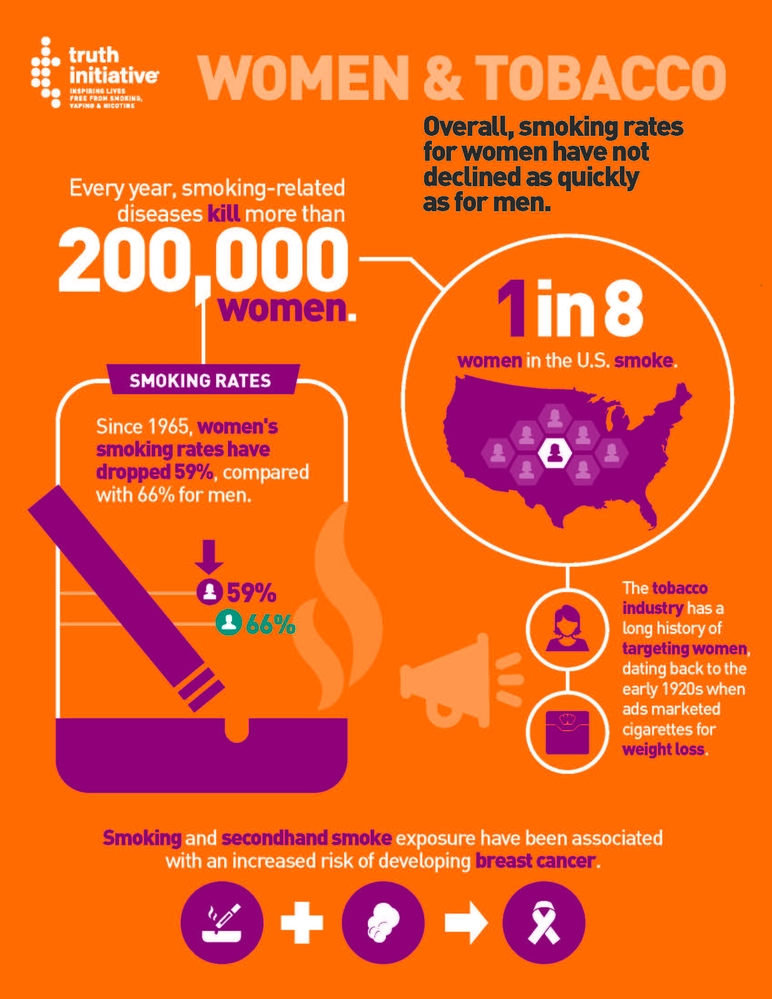
More in targeted communities
Want support quitting? Join EX Program
By clicking JOIN, you agree to the Terms, Text Message Terms and Privacy Policy.
Msg&Data rates may apply; msgs are automated.


